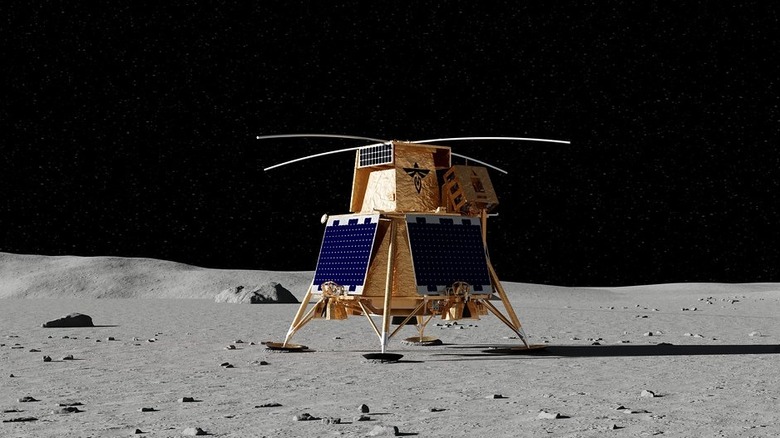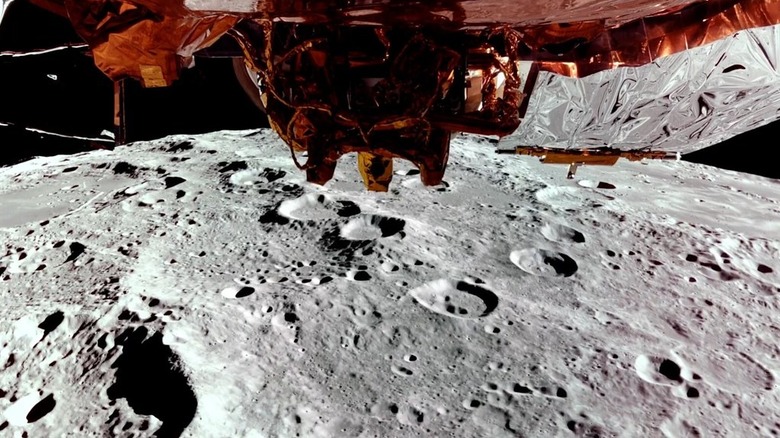A Private American Spacecraft Has Landed On The Moon (And Here's Why It Matters)
An American spacecraft has landed on the Moon for the first time in decades, and surprisingly, it wasn't from NASA. On March 2, 2025, Firefly Aerospace's Blue Ghost Mission 1 successfully landed in the Mare Crisium region of the Moon, following a 45-day journey across space. Immediately after the craft landed close to Mons Latreille, a location selected because of its volcanic past, it began relaying data back to Earth.
What makes this such a significant moment is who made it happen and the fact that the landing itself went smoothly. For Firefly, a soft lunar landing is now very much a reality, having previously only been done by a private company once before. Janet Petro, the current NASA Administrator, hailed the partnership and confirmation of the mission's success as evidence that "NASA and American companies are leading the way in space exploration for the benefit of all." This is not the first time NASA has embraced private partnerships either, with collaborative ventures like Lockheed Martin planning on saving the mission to Mars.
Ten NASA payloads, which were intended to collect data on lunar dust, heat flow, and navigation, were carried by the lander. These payloads will contribute to the Artemis program's long-term goal of making missions to the Moon more sustainable. In other words, the Blue Ghost is not just a wealthy enthusiast's science experiment; it's spearheading a movement to make lunar exploration a regular occurrence rather than a once-in-a-generation NASA mission.
The strategy used by NASA is evolving
The landing of Blue Ghost also serves as a demonstration of NASA's Commercial Lunar Payload Services (CLPS) program, which challenges the conventional model of spaceflight. The way CLPS works is that private companies compete for contracts to deliver scientific equipment to the Moon, rather than NASA designing, building, and flying every spacecraft. It's a quicker, less expensive method of achieving results, allowing startups to establish themselves while transferring some of the risk away from taxpayers.
The results of this strategy have already begun to appear. Following the success of Intuitive Machines' Odysseus mission in 2024, Firefly's landing signifies two consecutive years of commercial success. Thanks to more frequent missions and a constant stream of data, NASA can now refine Artemis hardware before humans have even set foot back on the Moon. It serves as a testing ground for businesses like Firefly, as well as assisting in the development of sustainable lunar economies and improving technology.
These partnerships are about more than just efficiency and budgets. NASA is fostering innovation at a rate it could never achieve on its own by contracting out lunar deliveries. Luckily, the mission has been smooth thus far, unlike a few SpaceX rockets that have exploded this year.
Firefly's contribution to Moon research
Firefly's Blue Ghost was carrying a serious load of gear, one akin to a wish list for future explorers. Arguably, the most important piece of equipment is the Lunar GNSS Receiver Experiment (LuGRE), which successfully detected weak Galileo and GPS signals on the Moon for the very first time. The lander was also carrying a drill capable of reaching ten feet below the lunar surface in order to gather information on heat flow and crust composition. Together with devices that gauge soil characteristics and magnetic fields, these instruments will aid researchers in piecing together the Moon's internal structure and volcanic past.
Even the technique for gathering soil was experimental; it uses gas bursts rather than robotic arms, which is lighter, consumes far less energy, and may make future missions easier. Then there is the issue of lunar dust, which NASA says is a big problem. The sticky and abrasive regolith that's referred to as lunar dust is infamous for clinging to spacesuits and damaging equipment. Blue Ghost is observing how the dust behaves during what's known as twilight conditions, which is when grains may levitate due to electric fields close to the Moon's "terminator", the boundary line dividing lunar day from night. This information will inform the design of rovers, seals, and astronaut equipment for years to come.
The success of the mission is a serious credibility boost for Firefly Aerospace. It's easy to understand why CEO Jason Kim described the mission as "literally and figuratively over the Moon." This landing is a true milestone and step forward into the joint future of space exploration between NASA and private companies.


